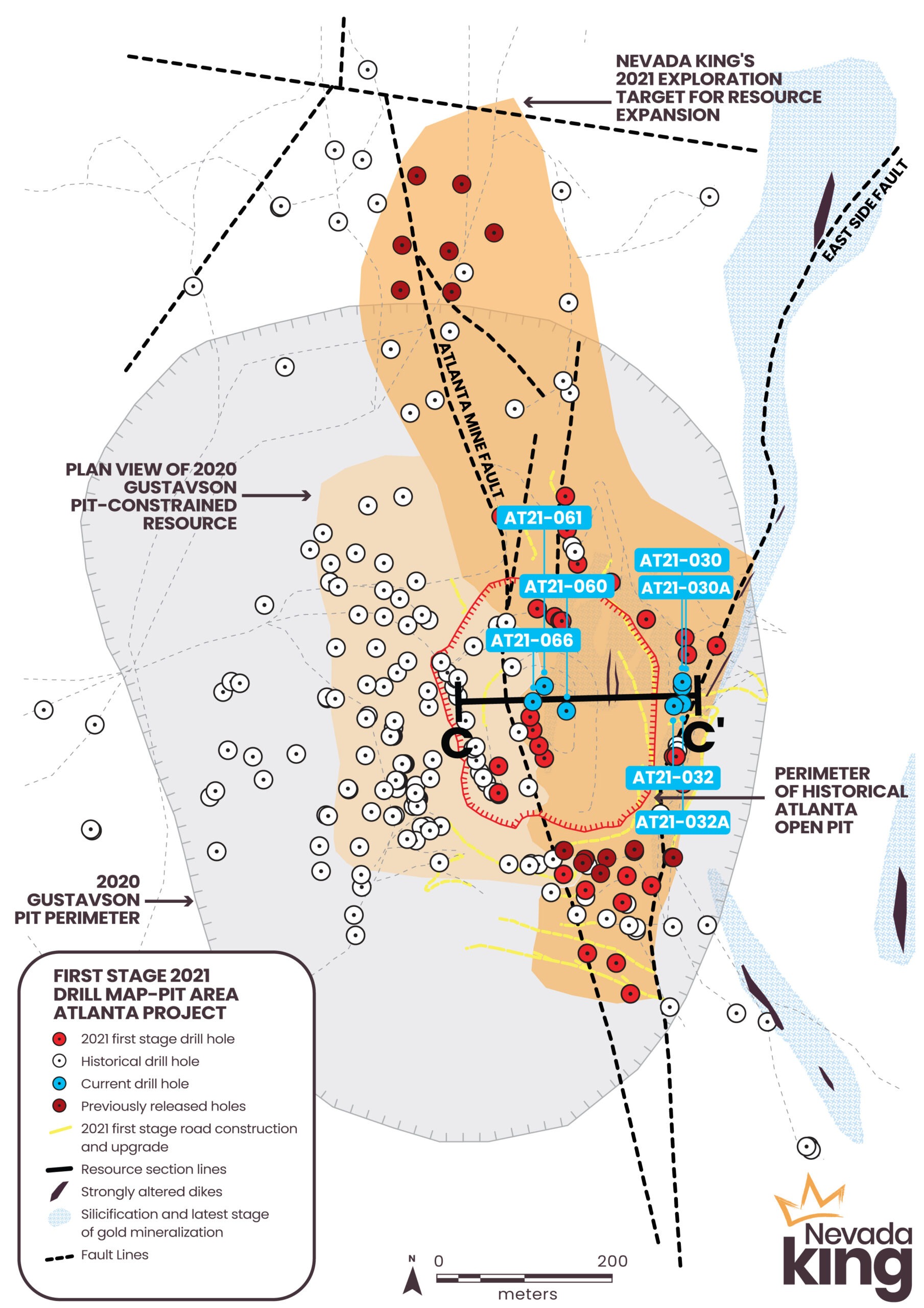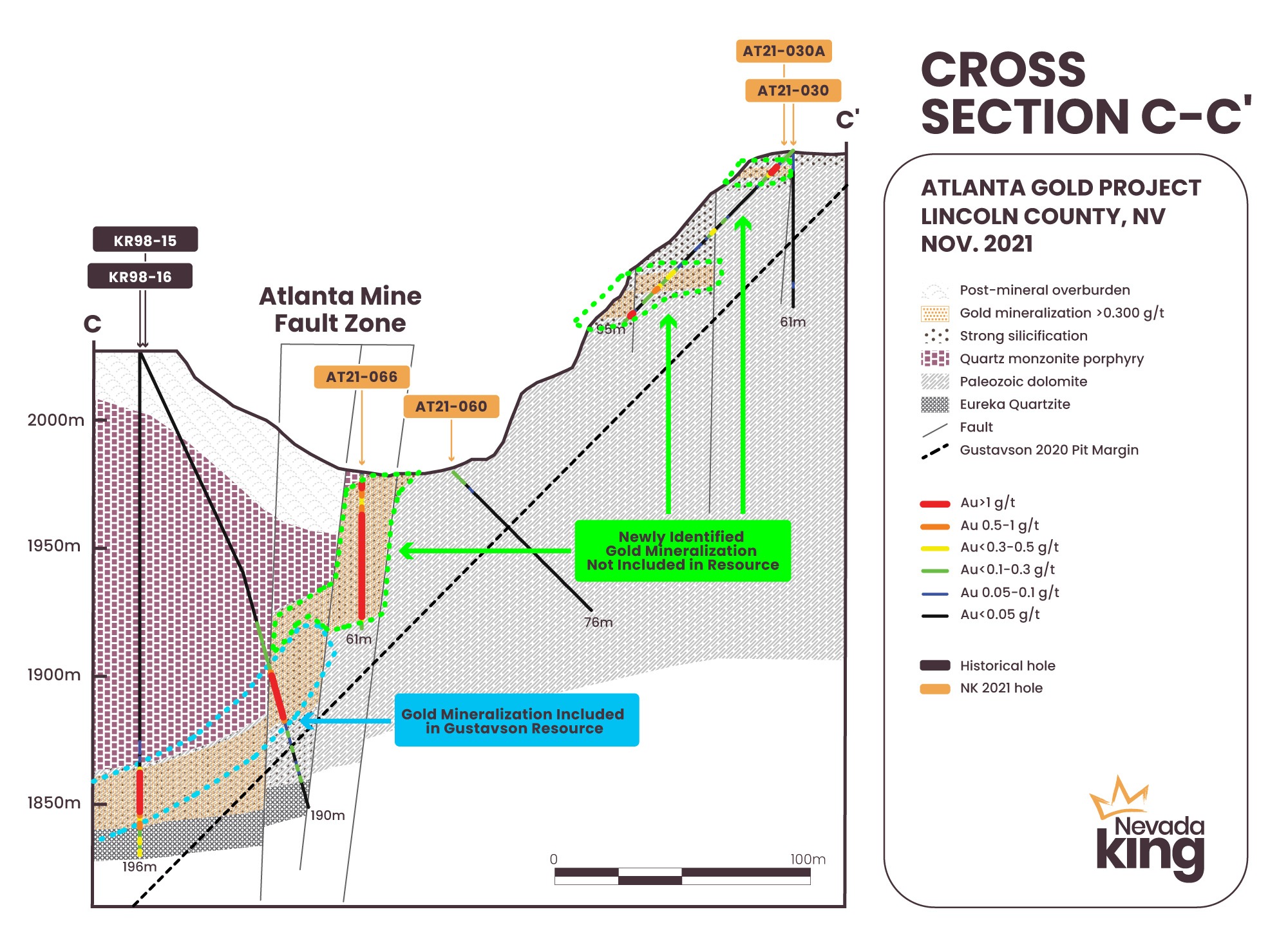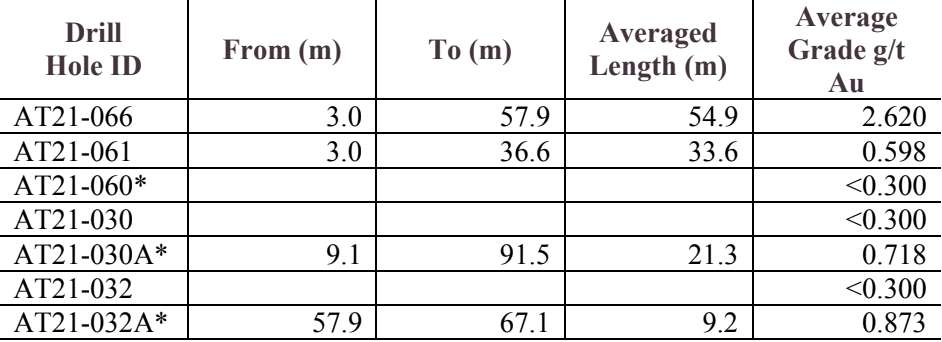VANCOUVER, BC, December 1, 2021 – Nevada King Gold Corp. (TSX-V: NKG; OTCQB: VKMTF) (“Nevada King” or the “Company”) is excited to announce that one of its reverse circulation (RC) exploration drill holes intercepted 54.9 metres grading 2.62 g/t of oxide gold mineralization starting at surface from within the north-east corner of the Atlanta open pit at the 100% owned Atlanta Gold Mine Project located 264 km northeast of Las Vegas, Nevada, in the prolific Battle Mountain Trend. This hole is one of several vertical holes drilled along the western edge at the bottom of the pit (Figure 1) in an area that had not previously been drill-tested.
Highlights
- Vertical RC drill hole AT21-066 drilled from within the Atlanta pit encountered 54.9m grading 2.62 g/t Au starting at 3m depth.* The mineralized rock is oxide material and includes a high-grade intercept of 3m averaging 13.35 g/t Au from 51.8m to 54.8m.
- The newly identified mineralization in AT21-066 is located within the confines of the Gustavson 2020 conceptual open pit but, importantly, is not currently included in the pit-constrained resource model. These results clearly demonstrate high-grade potential along the western margin of the historical Atlanta Mine open pit and show the possibility of increasing mineralized tonnage while decreasing strip ratio in a mining scenario (see Figure 2).
- Furthermore, this intercept ties the western margin of the Gustavson resource model (which is west of and 100-150m below the pit floor) to the at-surface mineralization within and around the pit, particularly in areas that had not been previously drilled.
- The Atlanta project currently has an estimated pit-constrained measured and indicated resource of 460,000 oz Au grading 1.3 g/t Au and an inferred resource of 142,000 oz Au grading 0.83 g/t Au at Atlanta. (See “NI-43-101 Technical Report on Resources” prepared by Gustavson Associates filed in the Company’s SEDAR filings.)
*True thickness of Au mineralization is currently unknown and must be determined with additional drilling.
Cal Herron, Exploration Manager of Nevada King stated, “Nevada King’s 2021 drilling program at Atlanta was designed to accomplish two primary objectives: (1) expand the Gustavson resource model to the north, south, and east of the historical pit, and (2) determine whether higher grade mineralization seen in deeper portions of the resource model extend upward toward the surface. Nevada King’s drill holes along section line C-C’ (Figure 2) are cleary significant steps towards accomplishing these objectives. The near-horizontal mineralization outcropping along the eastern pit wall was expected, as we see similar type mineralization along sections A-A’ (released November 16, 2021) and B-B’ (released November 22, 2021). However, the long, moderate grade intercept of 54.9m averaging 2.62g/t Au in AT-21-066 was completely unexpected, as there was no indication of this grade and thickness based on historical holes drilled in the vicinity. This hole clearly demonstrates shallow high-grade oxide mineralization beneath the historical pit that falls within the current conceptual pit. More drilling is planned to define the geometry and grade of this shallow mineralization and significantly add to the current gold resource at Atlanta.”


Drill Results Along Section C-C’ and in the Vicinity
Assay results from Nevada King’s RC drilling along Section C-C’ and within the vicinity are reported below in Table 1. The reported intercepts are down-hole lengths and do not represent true thickness of mineralization. However, the intercepts in AT21-61 and AT21-62 may be close to true thickness, but additional drilling is needed for ascertaining the actual geometry of the mineralized zone. Averaged intercepts utilize a 0.30 g/t external cut-off grade.
Table 1.

The western wall of the Atlanta pit consists of partially consolidated tuffaceous sandstone and tuff, both of which are soft and friable. Consequently the original mine benches were rapidly eroded away soon after cessation of mining in 1985 and access to the lower portions of the open pit was lost. This in large part explains why no exploration drilling was done in the pit by Goldfields (1989-1991), Kinross (1996-1998) and Meadow Bay (2011-2018). Instead of cleaning the pit out, these former explorers opted for long, westward-directed angle holes that collared outside of the pit along its western margin, but this meant the mineralized intercepts would be deep, the shallowest being about 100m beneath the pit floor. This also meant any serious resource calculation would stop well beneath the pit floor and would not include any mineralization within and east of the pit. In addition, the semi-consolidated volcanic sandstone introduced technical challenges for the RC drilling in terms of hole stability and sample contamination, thus increasing cost and raising sample QAQC issues.
In early 2020, the southwestern corner of the Atlanta pit started to collapse, such that by early 2021 about 10m of surface subsidence had occurred. This localized vertical subsidence is most probably due to collapse of underground stopes mined-out during the early 1900s. Assuming high grade material was mined from these shallow stopes, Nevada King decided to re-open the pit access ramp and drill along the northern extension of the collapse zone, which runs along the lower pit bench immediately west the pit floor. AT21-066 is the northernmost of five vertical RC holes drilled along this bench.
The two RC holes shown on the western end of section C-C’ in Figure 2, KR-98-15 and KR-98-16, were drilled by Kinross in 1998 at the western edge of the pit. Angle hole KR-98-15 cut 19.8m averaging 1.799g/t Au from 135.7m to 155.5m, with the highest grade interval running 3.72 g/t over 1.7m. This gold hit in KR-98-15 was the shallowest intercept within the central portion of the Gustavson 2020 resource model, and at that time there was no drill information east of the intercept that would allow Gustavson to extend the mineralization up to the pit floor. There was certainly no indication of potential for the type of intercept returned in Nevada King’s AT21-066: 54.9m grading 2.62 g/t Au from 3m to 57.9m, with a high-grade core of 3m averaging 13.35 g/t Au from 51.8m to 54.8m. Kinross hole KR-98-16 cut 22.9m grading 2.500g/t from 163.1m to 186.0m including a high grade core of 12.2m averaging 4.051g/t, but this relatively good gold intercept still pales in comparison to AT21-066. The intercept in AT21-066 was totally unexpected in view of the historical drill data and lack of historical exploration interest in this part of the deposit. We now see good potential for significantly expanding the existing resource model upward and eastward into the pit area with this discovery of moderate to high grade oxidized mineralization. Core drilling across and along strike of this shallow gold zone will better define both geometry and grade of mineralization in coming months.
Geologic mapping and sampling earlier this year identified several different zones of gold mineralization hosted within strongly silicified brecciated Laketown Dolomite along the eastern pit wall, but the geometry of these mineralized zones was unclear. Angle hole AT21-030A drilled underneath the mineralized exposures and we can now see the near-horizontal nature of the mineralization, very similar to what was encountered along section A-A’ (released November 16, 2021). These remnant zones of mineralization occur within a series of down-dropped blocks along the eastern pit wall. Nearby angle hole AT21-032A (see Table 1) hit the same lower mineralized zone that was encountered in AT21-030A. The holes shown in Table 1 containing <0.300g/t Au penetrated the Ely Springs Dolomite unit that typically underlies the mineralized zone. Even though these holes did not make the 0.300g/t cut-off, they still host sections containing Au mineralization within the 0.200-0.300 g/t range. Bottle roll tests will determine whether or not this sub-grade material could be included within the resource model.
Reconnaissance sampling east of section C-C’ indicates mineralization continues eastward for about 200m along a high ridge bounding the pit’s eastern margin. This large area of silicification and low grade gold mineralization is now interpreted as being the upthrown eastward extension of the same near-horizontal mineralized zone that comprises the Gustavson resource model. The outcropping mineralization has not been historically drilled so Nevada King will initiate road construction and drilling east (and upslope) of AT21-030 in 2022.
Qualified Person
The scientific and technical information in this news release has been reviewed and approved by Calvin R. Herron, P.Geo., who is a Qualified Person as defined by National Instrument 43-101 (“NI 43-101”).
About Nevada King Gold Corp.
Nevada King is the third largest mineral claim holder in the State of Nevada, behind Nevada Gold Mines (Barrick/Newmont) and Kinross Gold. Starting in 2016 the Company staked large project areas hosting significant historical exploration work along the Battle Mountain trend located close to current or former producing gold mines. These project areas were initially targeted based on their potential for hosting multi-million ounce gold deposits and were subsequently staked following a detailed geological evaluation. District-scale projects in Nevada King’s portfolio include (1) the 100% owned Atlanta Mine, located 100km southeast of Ely, (2) the Lewis and Horse Mountain-Mill Creek projects, both located between Nevada Gold Mines’ large Phoenix and Pipeline mines, and (3) the Iron Point project, located 35km east of Winnemucca, Nevada.
The Atlanta Mine is a historical gold-silver producer with an NI 43-101 compliant pit-constrained resource of 460,000 oz Au in the measured and indicated category (11.0M tonnes at 1.3 g/t) plus an inferred resource of 142,000 oz Au (5.3M tonnes at 0.83 g/t). See the NI 43-101 Technical Report on Resources titled “Atlanta Property, Lincoln County, NV” with an effective date of October 6, 2020, and a report date of December 22, 2020, as prepared by Gustavson Associates and filed under the Company’s profile on SEDAR (www.sedar.com).
For more information, contact Collin Kettell at collin@nevadaking.ca or (301) 744-8744.
Cautionary Statements Regarding Forward Looking Information
Neither the TSX Venture Exchange nor its Regulation Services Provider (as that term is defined in the policies of the TSX Venture Exchange) accepts responsibility for the adequacy or accuracy of this release.
This news release contains certain “forward-looking information” and “forward-looking statements” (collectively “forward-looking statements”) within the meaning of applicable securities legislation. All statements, other than statements of historical fact, included herein, without limitation, statements relating the future operations and activities of Nevada King, are forward-looking statements. Forward-looking statements are frequently, but not always, identified by words such as “expects”, “anticipates”, “believes”, “intends”, “estimates”, “potential”, “possible”, and similar expressions, or statements that events, conditions, or results “will”, “may”, “could”, or” should” occur or be achieved. Forward-looking statements in this news release relate to, among other things, the Company’s exploration plans and the Company’s ability to potentially expand mineral resources and the impact thereon. There can be no assurance that such statements will prove to be accurate, and actual results and future events could differ materially from those anticipated in such statements. Forward-looking statements reflect the beliefs, opinions and projections on the date the statements are made and are based upon a number of assumptions and estimates that, while considered reasonable by Nevada King, are inherently subject to significant business, economic, competitive, political and social uncertainties and contingencies. Many factors, both known and unknown, could cause actual results, performance or achievements to be materially different from the results, performance or achievements that are or may be expressed or implied by such forward-looking statements and the parties have made assumptions and estimates based on or related to many of these factors. Such factors include, without limitation, the ability to complete proposed exploration work given the global COVID-19 pandemic, the results of exploration, continued availability of capital, and changes in general economic, market and business conditions. Readers should not place undue reliance on the forward-looking statements and information contained in this news release concerning these items. Nevada King does not assume any obligation to update the forward-looking statements of beliefs, opinions, projections, or other factors, should they change, except as required by applicable securities laws.
